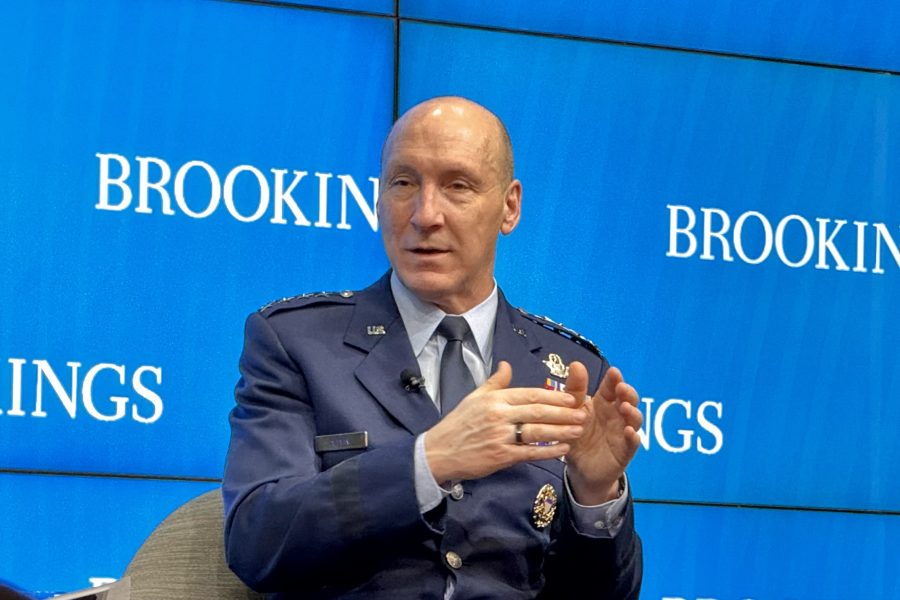A number of the significant organizational changes the Air Force laid out in mid-February will happen “fairly quickly,” Chief of Staff Gen. David W. Allvin said at a Brookings Institution event Feb. 28, adding the reshaping will be the central focus of his tenure. However, some of the changes may take beyond his term to implement.
Allvin said the service’s re-optimization aimed at competing with China that was rolled out at the AFA Warfare Symposium in Aurora, Colo “will come in stages.” He also said not all the changes needed have yet been fully developed, that they are likely to evolve as they are made, and that it will cost some money to make them. Nevertheless, the changes to come are essential to keeping the service combat credible, he argued.
The re-optimization is focused on four basic pillars: developing people, developing capabilities, readiness, and projecting power, Allvin explained.
“I believe there will be parts of this, particularly the ‘developing people’ part … we will get rolling fairly quickly,” Allvin said, singling out the evolution of Air Education and Training Command to Airman Development Command as something that will occur “not too far down the path.” Changing the authorities to make that organizational shift is “easier to do than … building new enterprises.”
He also said the leadership is anxious to stand up the new Integrated Capabilities Command “as soon as possible, because the sooner we start that, the sooner we can start changing the way that we build our [program objective memoranda] and our budgets and developing the future force.”
Allvin didn’t offer a specific timeline for implementing the other elements of the restructuring—or what elements he thought would take the longest—but he did say the Air Force will gear up for major new readiness exercises in the near term.
“They’re going to come in pieces,” Allvin said of the revisions, which include creating some new organizations and merging others while shifting the responsibilities and focus of some commands.
“I’m only going to be able to do this for four years—as long as I keep my job—but it’s all I’m going to be doing. It’s the thing I’m going to do from start to finish,” Allvin said.
“I don’t know that it will be fully done, by the time I complete” a four-year tenure as the Chief of Staff, he said. But after four or five years Allvin hopes to see a “drastically changed Air Force.”
Allvin said there was “imagination gone wild” in the media and the service about the re-optimization before it was announced, but the changes announced are really about “enterprise solutions” needed to avoid capabilities and organizations that can’t work together or that don’t further the fighting ability of the service.
The last comparable reorganization of the Air Force came in the early 1990s, Allvin said, when then-Chief of Staff Gen. Merrill McPeak had to “solve for efficiency,” in downsizing the USAF by about 40 percent after the end of the Cold War. This new reorganization is driven by the need to “solve for agility,” Allvin said, by making the Air Force’s processes and decision-making more nimble and fielding new capabilities swiftly.
“We’re rolling this out without having the actual, signed official document of what the end state looks like,” Allvin noted, saying the Air Force “will learn along the way.”
“If you know you’re heading in the right direction, you can learn along the way [as] you get to a better destination,” he said.
For example, Allvin said he could not say how many Airmen would be in Integrated Capabilities Command, “but we also can’t wait for that.”
The service also will “engage stakeholders” such as lawmakers on Capitol Hill “who can help you get to the right solution.” Allvin acknowledged that the plans so far are “unsatisfying to some” because end-states have not yet been determined.
It would be “fairly naïve” to say the changes will come without cost, because “if you want to change the name on a sign, it costs money,” Allvin said. However, he said re-optimization would not be a “large fiscal burden” on the Air Force, particularly at a time when its resources are already constrained, and limiting the budgetary impact “is going to be key to this.”
Socializing the changes within the service is already underway, but Allvin said the youngest cohort will adapt quickly. He said they already understand what the Air Force calls “Great Power Competition”—the challenge of China and Russia—and fully expect the service to align with it.
It will be a tougher sell with mid-career people, Allvin said.
They “understood the Air Force that got them to where they are, and they understood the path. And now if that path looks like it’s going to be altered, there’s some unease there. So our job is to communicate with those Airmen to say, ‘There’s still a fantastic path for the future for you. It might be altered from what you thought, but it’s just as robust and it’s just as important.’”
He added, “they call it the ‘frozen middle’ for a reason. There’s this natural skepticism.” Service leaders “have some work to do,” to communicate the reasons for the changes, Allvin said.
